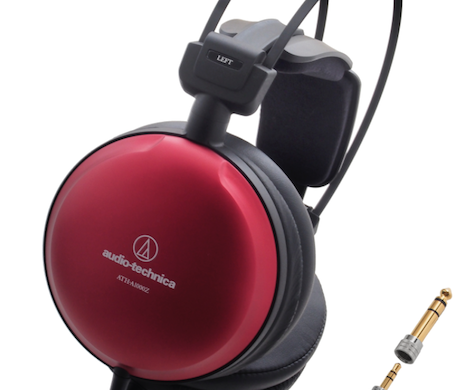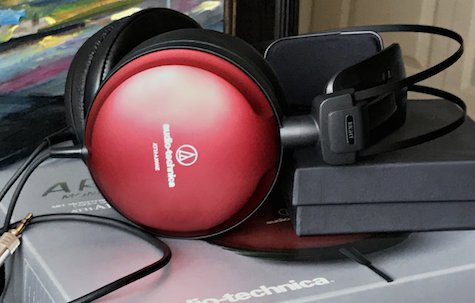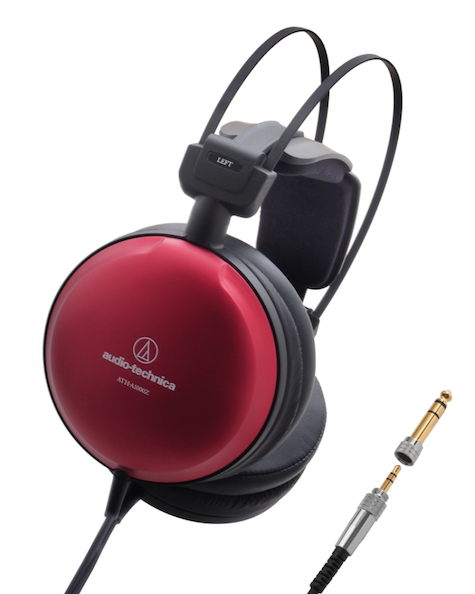ATH-1000z Art Monitor Closed Back Headphones
Company:Â Audio-Technica
$399 U.S.
Review notes: My first impressions of the sound of the Audio-Technica ATH-A1000z headphones (A1000z hereafter) are based on direct comparisons to other headphones, particularly those that resemble its design (closed-back studio monitor), but also to a few premium headphones for reference. I’ll describe how I relate to the A1000z (i.e., my personal tastes and how I use the headphone) only after covering all of the objective issues.
Getting right to the bottom line, the A1000z’s sound quality is better in many ways than most of my headphones that sold for $500 to $600 USD. The good news is that the bass is clean and detailed, and flows perfectly into the lower mids. In my experience, this is the correct design for when you want to hear the recording as the final mix was intended to sound.
There are a few weak points (these are caveats and don’t necessarily apply to all users). The deep bass is not as strong and has less impact than my average headphone, but it’s in the same ballpark as the Grado PS1000e or AKG K712. The A1000z has a significant output at 27.5 hz, which is the lowest note generally scored for an orchestra, but the fundamental tone at 16 hz doesn’t have significant impact, which likely doesn’t matter except for the occasional electronic EDM track. The lowest pedal notes in most pipe organ recordings are 27.5 hz or higher.
The treble is smooth and not bright, but also not recessed, as is the case with my latest $1000 headphone. Since the tonal variations from neutral or ‘flat’ aren’t significant compared to the smoothest and most neutral headphones I’ve had, I’ll say nothing further about the response (or ‘signature’) per se. Amping is the key to getting the most out of a true studio monitor like the A1000z, and while I found almost no difference between using the MacBook headphone port or using the DragonFly DAC/amp with the same computer, other desktop amps might add weight to the low bass.
My personal view is that the bass is true-neutral, and headphone users who gravitate toward that sound will love it. Since I’m not a basshead, I can make the A1000z my primary headphone, or use something like the Audio-Technica ESW990h that I also reviewed separately here at MyMac, which is a bassier headphone. It makes no difference to me since they’re close enough that 98 percent of my music tracks play perfectly on each.
Try “Katerine” by the Jim Ruiz Group or “Crying For No Reason” by Katy B, to get a sense of the typical bass impact and detail. These are not especially bassy recordings, but the A1000z provides a visceral thump that will compare favorably to most sub-$1000 planar headphones, understanding that the character of the bass is usually a little different between dynamic and planar headphones.
To best appreciate the midrange, listen to “Bailando Entre Espuma” by Israel ‘Cachao’ Lopez for its sharp-edged horn sounds, or “Trains” by Porcupine Tree for the sheer amount of percussive energy it contains. Many of the high-end headphones will sound a little too rough or edgy with these tracks, but the A1000z sails through them without harshness or significant colorations. Also check out “Optical Illusion (Billy Buttons Mix)” by William Orbit or “Wicked Game” by Chris Isaak, two high treble energy recordings that can be ear-scorchers with certain audiophile headphones. The A1000z plays these two tracks with silky smoothness.
The obvious question then is “Just how good is the A1000z sound or how much fidelity does it represent, without running into the strong sibilants and harshness that many of the flagship headphones produce with less-than-perfect recordings?” My answer: The A1000z treble is tuned for the maximum amount of detail that can be obtained shy of encountering the typical irritant factors heard with the brighter headphones. This is not a “relaxed” treble — it’s the right treble for making a recording master or for playback when the user wants to hear the final recording unfiltered.
For many years in the headphone world, higher levels of treble were considered ‘neutral’, but from what I hear the preponderance of recordings today were made for this type of headphone. And it’s not just modern recordings — many of the late-1950’s stereo remasters made for audiophile systems also sound just right.
Isolation is average or better for a good closed-back monitor. Leakage is low, but if playing music loudly in a quiet office or library, a person sitting next to the headphone will probably hear some faint sounds. The earpads are soft and squishy, and covered with a good grade of plastic that should hold up well. The earcup openings are round and fit my average-size ears just fine, but users with very large ears might find that these earpads don’t go fully around their ears.
The headband is a one-size-fits-all, pull-down to fit, and it works very comfortably for me. The range of adjustment is a good bit larger and smaller than where I fit, so the A1000z should fit nearly all heads. There’s a moderate degree of earcup rotation, and that should also accomodate nearly every head. The A1000z comes with a 3 meter non-detachable cable, terminated with a 3.5 mm miniplug (6.35 mm adapter is included), and terminated at each attractive red earcup with a sturdy-looking strain relief.
___________________________________
In addition to the music tracks noted above, I’m including a few more examples below with comments about how the A1000z sounds with each track, in case a reader wants to compare these comments to other reviews I’ve done to evaluate the differences.
Link to our YouTube review
Sources: iPhone 7+ with Oppo HA-2/AudioQuest DragonFly Black DAC/amps, various computers using the AudioQuest DragonFly v1.2/Lehmann Traveller DAC/amps.
Beethoven Symphony 9, Solti/CSO (1972): Excellent overall sound. Of special note here are the bass impacts beginning around 10:30 of the fourth movement. Those impacts are soft and well in the background, but you can feel some of the weight they carry with the A1000z.
Chromatics – I’m On Fire (Synth-Pop, female lead): This track with the A1000z has a good amount of space around the voice and instruments, making for a very pleasant stereo image. The voice is excellent, and the tambourine sound is clearly identifiable.
Hans Zimmer – Dark Knight-Aggressive Expansion (Soundtrack): The percussion in this track hits really hard, and the bass tones beginning around 0:45 have some of the ultra-deep “shuddery” kind of sound and feel that indicates a useful deep-bass response. Overall, the A1000z plays this music very well.
Michael Tilson Thomas – Rhapsody In Blue (20th Century Classic): Great sound and soundstage, and terrific piano playing and tone. There are some very deep bass impacts starting around 38 seconds into the 17:24 length track, and the weight of those impacts is subtle with the A1000z.
Trombone Shorty – Backatown (Jazz-Funk): The deep bass impacts here are strong and work well with the horns and other instruments. The A1000z delivers the impacts with decent weight and detail, and the horns have the kind of bite that gives them a wonderfully realistic sound.
___________________________________
MyMac Review Rating is 9 out of 10 for combination of price and sound quality




Leave a Reply
You must be logged in to post a comment.